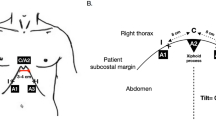Abstract
Purpose
To evaluate the status of limited upper sternal split in general thoracic surgery.
Methods
We reviewed the clinical files of 100 consecutive patients operated on through limited upper sternotomy at a hospital in Italy during the 10 years between January 1995 and December 2004.
Results
Thymus surgery represented the main indication for this approach (n = 51): for myasthenia without thymoma in 28 patients, for thymus neoplasms with or without myasthenia in 22, and for intrathymic parathyroid adenoma in 1. Thyroid surgery constituted the second main indication for upper sternal split (n = 32) for benign retrosternal goiter in 18 patients, for mediastinal nodal metastasis of thyroid cancer in 11, and for malignant retrosternal goiter in 3. The remaining indications were as follows: to assess residual disease following chemotherapy for Hodgkin’s disease in 7 patients and for non-Hodgkin lymphoma in 1; for tracheal surgery in 7; and for excision of nodal mediastinal metastasis of non-thyroid cancer in 2. All operations were completed through the upper sternal split. There was no surgical mortality but complications developed in eight patients.
Conclusion
The upper sternal split provides a satisfactory access to perform a surgical procedure in the superior mediastinum in most diseases. The procedure is safe and involves minimal surgical trauma.
Similar content being viewed by others
References
Pego-Fernandes PM, de Campos JR, Jatene FB, Marchiori P, Suso FV, de Oliveira SA. Thymectomy by partial sternotomy for the treatment of myasthenia gravis. Ann Thorac Surg 2002;74:204–208.
LoCicero J III. The combined cervical and partial sternotomy approach for thymectomy. Chest Surg Clin N Am 1996;6:85–93.
Detterbeck FC, Scott WW, Howard JF Jr, Egan TM, Keagy BA, Starek JK, et al. One hundred consecutive thymectomies for myasthenia gravis. Ann Thorac Surg 1996;62:242–245.
Roth T, Ackermann R, Stein R, Inderbitzi R, Rosler K, Schmid RA. Thirteen years follow-up after radical transsternal thymectomy for myasthenia gravis: do short-term results predict longterm outcome? Eur J Cardiothorac Surg 2002;21:664–670.
Ferguson MK. Transcervical thymectomy. Semin Thorac Cardiovasc Surg 1999;11:59–64.
Bril V, Kojic J, Ilse WK, Cooper JD. Long-term clinical outcome after transcervical thymectomy for myasthenia gravis. Ann Thorac Surg 1998;65:1520–1522.
Boaron MA. A new retraction-suspension device for limited upper sternotomy. Ann Thorac Surg 2004;77:1107–1108.
Grunenwald D, Spaggiari L. Transmanubrial osteomuscular approach for apical chest tumors. Ann Thorac Surg 1997;63:563–566.
Kim J, Ahn W, Bahk JH. Hemomediastinum resulting from subclavian artery laceration during internal jugular catheterisation. Anesth Analg 2003;97:1257–1259.
Szwerc MF, Benckart DH, Wiechmann RJ, Savage EB, Szydlowski GW, Magovern GJ, et al. Partial versus full sternotomy for aortic valve replacement. Ann Thorac Surg 1999;68:2209–2213.
Gillinov AM, Banbury MK, Cosgrove DM. Hemisternotomy approach for aortic and mitral valve surgery. J Card Surg 2000;15:15–20.
Maggi G, Casadio C, Cavallo A, Cianci R, Molinatti M, Ruffini E. Thymectomy in myasthenia gravis. Results of 662 cases operated upon in 15 years. Eur J Cardiothorac Surg 1989;3:504–509.
Cooper JD, Al-Jilaihawa AN, Pearson FG, Humphrey JG, Humphrey HE. An improved technique to facilitate transcervical thymectomy for myasthenia gravis. Ann Thorac Surg 1988;45:242–247.
Takeo S, Sakada T, Yano T. Video-assisted extended thymectomy in patients with thymoma by lifting the sternum. Ann Thorac Surg 2001;71:1721–1723.
Trastek VF. Thymectomy. In: Kaiser LR, Kron IL, Spray TL, editors. Mastery of cardiothoracic surgery. Philadelphia: Lippincott-Raven; 1998. p. 105–111.
Madjar S, Weissberg D. Retrosternal goiter. Chest 1995;108:78–82.
Netterville JL, Coleman SC, Smith JC, Smith MM, Day TA, Burkey BB. Management of substernal goiter. Laryngoscope 1998;108:1611–1617.
Mussi A, Ambrogi MC, Iacconi P, Spinelli C, Miccoli P, Angeletti CA. Mediastinal goitres: when the transthoracic approach? Acta Chir Belg 2000;100:259–263.
Rea F, Callegaro D, Loy M, Zuin A, Narne S, Gobbi T, et al. Benign tracheal and laryngotracheal stenosis: surgical treatment and results. Eur J Cardiothorac Surg 2002;22:352–356.
Author information
Authors and Affiliations
Rights and permissions
About this article
Cite this article
Alifano, M., Forti Parri, S.N., Arab, W.A. et al. Limited upper sternotomy in general thoracic surgery. Surg Today 38, 300–304 (2008). https://doi.org/10.1007/s00595-007-3626-1
Received:
Accepted:
Published:
Issue Date:
DOI: https://doi.org/10.1007/s00595-007-3626-1




